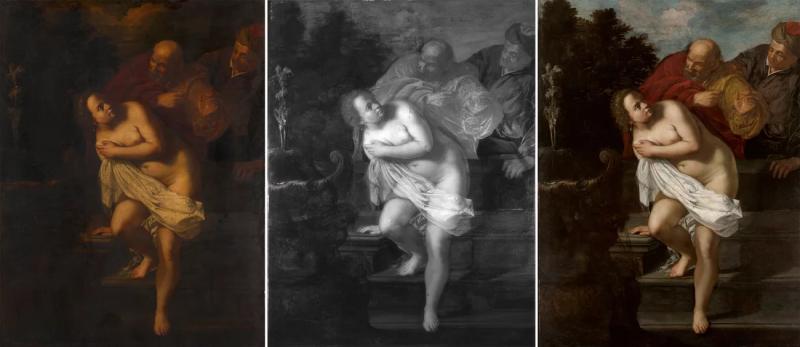Iconic female artist's lost painting is found, hundreds of years after it was created



Susanna and the Elders , painted by Artemisia Gentileschi, is seen here in its before-conservation condition; seen through infrared reflectography; and in its restored state.
Royal Collection Trust / © His Majesty King Charles III 2023
The painting once enjoyed pride of place, hanging in a queen's chambers. Then centuries of varnish, overpaint and dirt obscured not only the work but also its artist. The layers of history have now been pulled back, revealing a striking work by a singular artist that was once thought lost.
Or, to tell the story another way: the king of England's attic is not like your attic.
The painting by Artemisia Gentileschi, Susanna and the Elders , had lost its frame and attribution by the time it was put into storage more than 100 years ago. But it's now returning to the public eye, after it was unearthed in an inventory of art held by King Charles I (who, we'll remind you, died in 1649 ).
It's the latest boon for an artist who has at times been more defined by her famous personal story — Artemisia, daughter of a prominent painter, was raped at 17 and then tortured at trial — than by her artistic skill and defiance of expectations.
"We are so excited to announce the rediscovery of this important work by Artemisia Gentileschi," said Anna Reynolds, deputy surveyor of The King's Pictures, as the Royal Collection Trust unveiled the restored painting at Windsor Castle.
"Artemisia was a strong, dynamic and exceptionally talented artist whose female subjects — including Susanna — look at you from their canvases with the same determination to make their voices heard that Artemisia showed in the male-dominated art world of the 17th century," Reynolds added.
Extensive restoration revealed the painting
The painting dates to the late 1630s, and its true worth emerged like something from a royal version of Antiques Roadshow. For more than 100 years, Artemisia's painting was wrongly attributed simply to "French School," according to the Royal Collection Trust.
During a recent inventory, curators realized the canvas's shadowy subjects matched a description of Susanna and the Elders in previous records, depicting the biblical story of a beautiful young woman being leered at by older men at her bath. It was one of several compositions Artemisia painted of the subject.

Conservator Adelaide Izat works on Susanna and the Elders. At this stage of the work, the painting's left half was still covered by dirt, overpaint and varnish.
X-radiography analysis and infrared reflectography revealed layers that were invisible to the naked eye. Some of those examinations revealed Artemisia's work process, showing elements she altered. The restoration also uncovered details and colors that viewers saw in the 17th century, but had since been muted by thick varnish. Repairing it was painstaking work.
"When it came into the studio, Susanna was the most heavily overpainted canvas I had ever seen, its surface almost completely obscured," conservator Adelaide Izat said. "It has been incredible to be involved in returning the painting to its rightful place in the Royal Collection, allowing viewers to appreciate Artemisia's artistry again for the first time in centuries."
Conservation also revealed that the letters CR — for Carolus Rex — were found branded on the back of the canvas, proving the painting was part of King Charles I's collection.
Artemisia's work has been newly appreciated
Artemisia Gentileschi was born in Rome in 1593. Her father, artist Orazio Gentileschi , was a follower of Caravaggio — and that style's dark realism suited itself well to Artemisia's work.
In a bold move for a female artist of the era, Artemisia depicted women not as the subject of portraiture but as the central characters in dramatic narratives. Another of her celebrated biblical works depicts Judith, the Old Testament figure who beguiles — and then decapitates — the Assyrian general Holofernes.

Artemisia Gentileschi painted this work, Self-portrait as the Allegory of Painting , around 1638–39 — the same period as her Susanna and the Elders.
Artemisia has had a renaissance of her own in recent decades, including a major exhibition at Rome's Palazzo Braschi , where 30 of her works went on display in 2016. She has also inspired a documentary and a graphic novel .
The newly recovered painting of Susanna and the Elders was commissioned by Queen Henrietta Maria, wife of Charles I (and also Maryland's namesake ).
"One of the most exciting parts of this painting's story is that it appears to have been commissioned by Queen Henrietta Maria while her apartments were being redecorated for a royal birth," art historian Niko Munz said. Noting its spot above a fireplace, he added, "It was very much the Queen's painting."
At Whitehall Palace, it hung in the "Queen's Withdrawing Chamber," according to a 1639 royal inventory. But by the next century, it was relegated to leaning against a wall, as Artemisia's renown faded. It wound up in storage at Hampton Court Palace.
In its new home at Windsor Castle, Susanna and the Elders hangs in the Queen's Drawing Room, displayed alongside a self-portrait by Artemisia and a painting by her father.
Tags
Who is online
29 visitors

NPR does not have a paywall, here are 2 more stories on the great Artemisia Gentileschi:
A censored nude painting from 1616 is set to be digitally unveiled
Long Seen As Victim, 17th Century Italian Painter Emerges As Feminist Icon
Wasn't there a similar story recently about someone finding a lost painting by a famous artist, and nobody believed him?
Chuck Close and Artemisia Gentileschi were both painters but any comparison stops there.